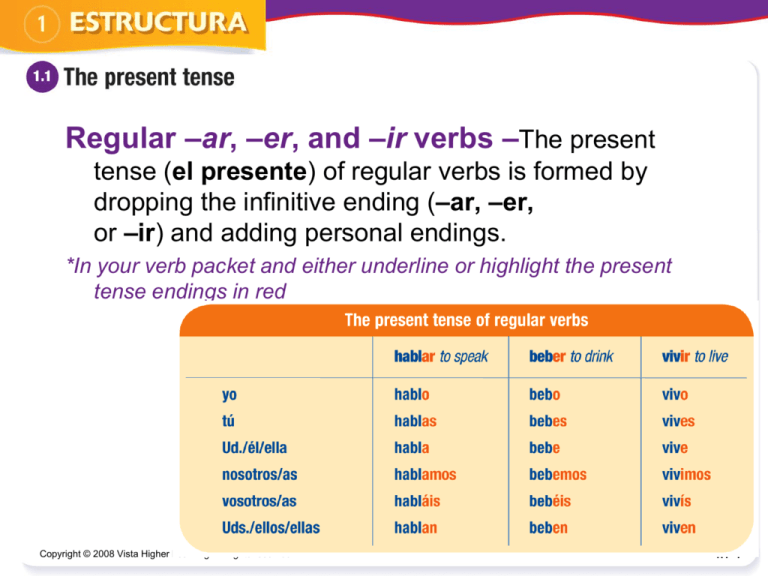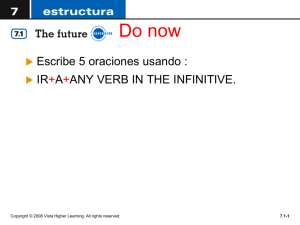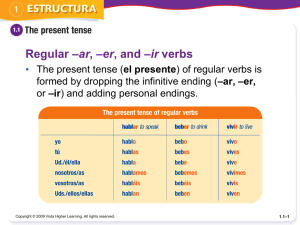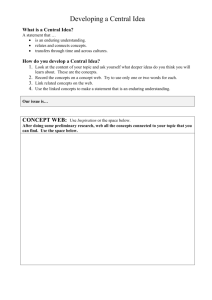
Regular –ar, –er, and –ir verbs –The present
tense (el presente) of regular verbs is formed by
dropping the infinitive ending (–ar, –er,
or –ir) and adding personal endings.
*In your verb packet and either underline or highlight the present
tense endings in red
Copyright © 2008 Vista Higher Learning. All rights reserved.
1.1–1
• The present tense is used to express actions
or situations that are going on at the present
time and to express general truths.
¿Te mantienes en contacto con
tus primos?
Sí, los llamo cada semana
Do you stay in touch with
your cousins?
Yes, I call them every week.
Copyright © 2008 Vista Higher Learning. All rights reserved.
1.1–2
• The present tense is also used to express
habitual actions or actions that will take place
in the near future.
Mis padres me escriben con
frecuencia.
Mañana les mando una
carta larga.
My parents write to me often.
Tomorrow I’m sending
them a long letter.
Copyright © 2008 Vista Higher Learning. All rights reserved.
1.1–3
• Subject pronouns are normally omitted in Spanish. They are
used to emphasize or clarify the subject.
¿Viven en California? Do (they) live in California?
Sí, ella vive en Los Ángeles y él vive
en San Francisco.
Yes, she lives in L.A. and he lives in S.F.
Copyright © 2008 Vista Higher Learning. All rights reserved.
1.1–4
Stem-changing verbs – Get out your verb packet and
either highland or underline stem change in the present tense of
poder and pedir
• Some verbs have stem changes in the present tense.
In many –ar and –er verbs, e changes to ie and o changes to ue.
In some –ir verbs, e changes to i.
The nosotros/as and vosotros/as forms never have a stem
change in the present tense.
Copyright © 2008 Vista Higher Learning. All rights reserved.
1.1–5
• Jugar changes its stem vowel from u to ue. As with other
stem-changing verbs, the nosotros/as and vosotros/as
forms do not change.
jugar
juego, juegas, juega,
jugamos, jugáis, juegan
Copyright © 2008 Vista Higher Learning. All rights reserved.
1.1–6
(continued)
• Construir, destruir, incluir, and influir have a spelling
change and add a y before the personal endings (except the
nosotros/as and vosotros/as forms).
incluir
incluyo, incluyes, incluye,
incluimos, incluís, incluyen
Copyright © 2008 Vista Higher Learning. All rights reserved.
1.1–7
Irregular yo forms
• Many –er and –ir verbs have irregular yo forms in the
present tense. Verbs ending in –cer or –cir change to –zco
in the yo form; those ending in –ger or –gir change to –jo.
Several verbs have irregular –go endings, and a few have
individual irregularities.
Copyright © 2008 Vista Higher Learning. All rights reserved.
1.1–8
Copyright © 2008 Vista Higher Learning. All rights reserved.
1.1–9
• Verbs with prefixes follow these same patterns.
Copyright © 2008 Vista Higher Learning. All rights reserved.
1.1–10
Irregular verbs
• Other commonly used verbs in Spanish are irregular in
the present tense or combine a stem change with an
irregular yo form or other spelling change.
Copyright © 2008 Vista Higher Learning. All rights reserved.
1.1–11
• Some verbs with irregular yo forms have stem changes as well.
conseguir (e:i) → consigo
to obtain
seguir (e:i) → sigo
to follow
corregir (e:i) → corrijo
to correct
elegir (e:i) → elijo
to choose
Copyright © 2008 Vista Higher Learning. All rights reserved.
1.1–12






